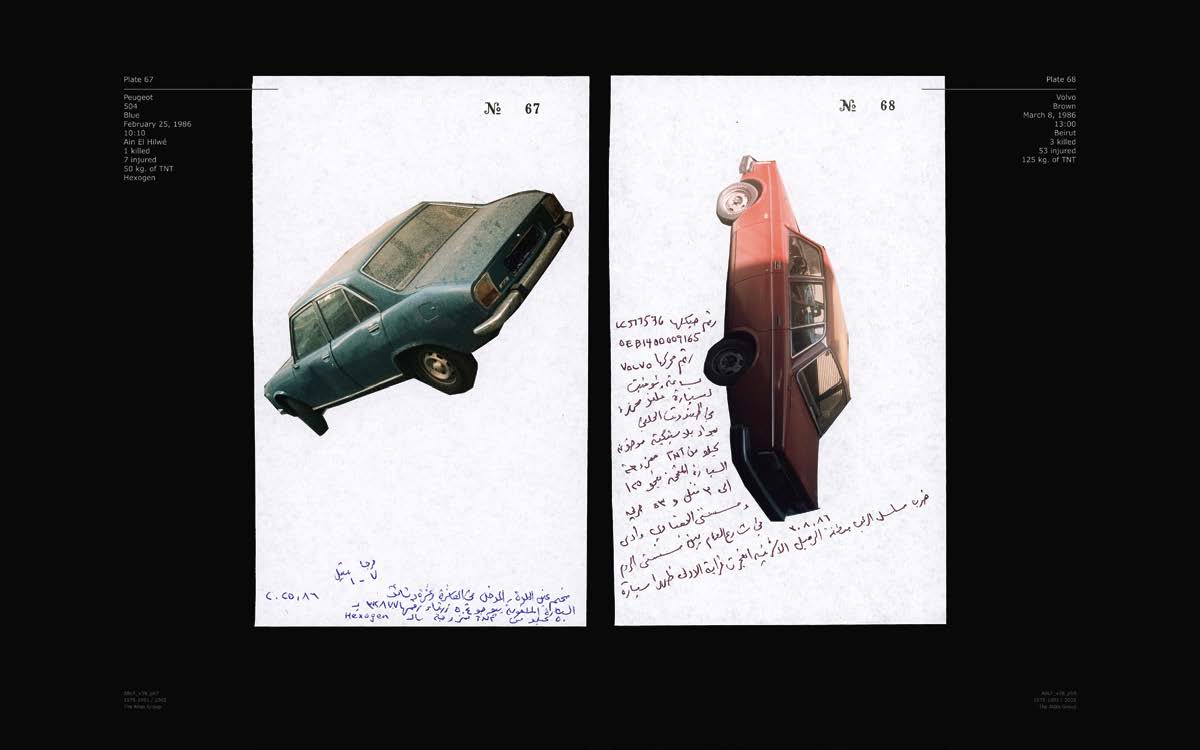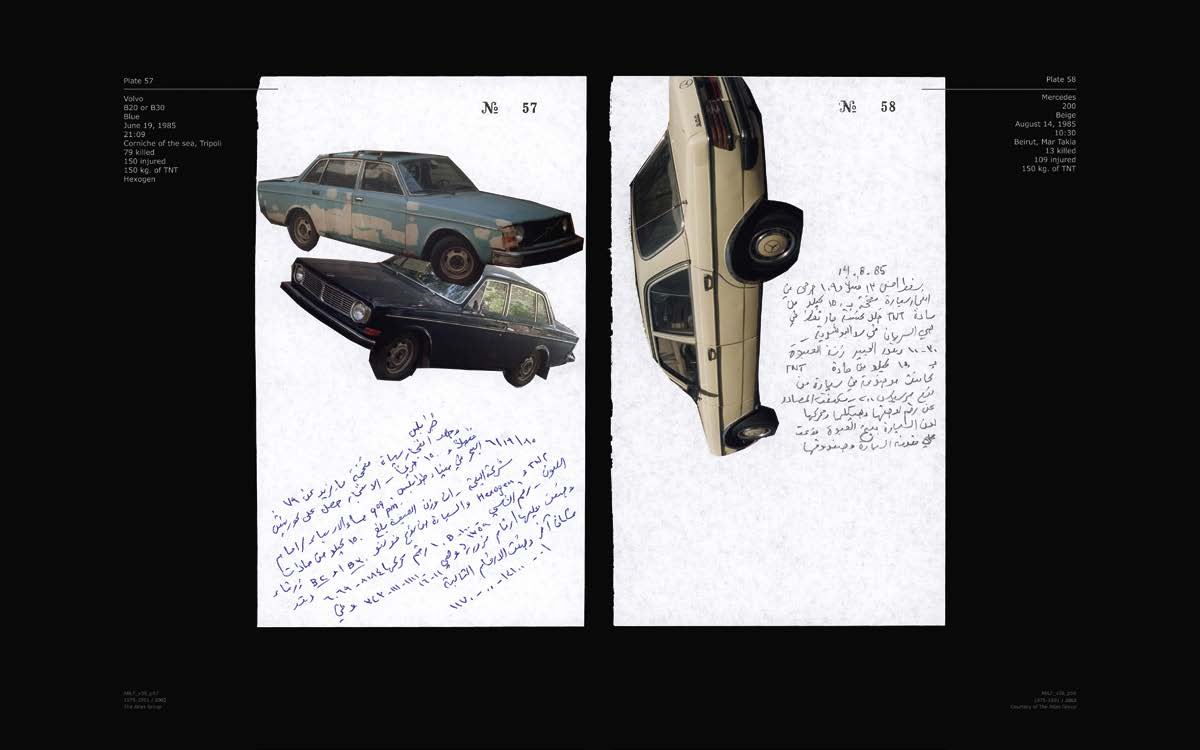The Atlas Group / Walid Raad
The Atlas of Explosions
As part of his project The Atlas Group (1989–2004), the LebaneseAmerican artist Walid Raad collected documents related to the contemporary history of Lebanon. Raad presents the results of The Atlas Group as a collective work, attributing joint authorship to several fictitious characters. One of these “contributors” is Dr. Fadl Fakhouri, who among other things is presented as the author of the series Already Been in a Lake of Fire: Notebook Volume 38 (1991/2003), relating to 145 car bomb attacks, of which there were a total of 3641 with 4386 victims during the civil war in Lebanon in the years 1975–1991.1 Highly mobile, readily available and treacherously inconspicuous, car bombs are a deadly war machine symptomatic of current urban warfare, where the line between militias and civilians is itself tactically blurred.
In Notebook Volume 38, Dr. Fakhouri pastes cut-out reproductions of vehicles on white sheets. He presents the cars as serially produced – technically reproducible commodities, much like photography. Selecting the same automobiles which were used as car bombs, he refers to the destiny of individual items, and the singularity of their fateful end as well as the uniqueness of the human lives lost in each explosion, or which were changed by it forever. The specific nature of the historical events in Notebook Volume 38 is not mediated through photography, but through handwritten captions in Arabic detailing the circumstances, which serve as a framing device to each cut-out. These cite the brand name and make of the car, the place, date and time of the explosion, the total number of casualties, amount of explosives used, and sometimes even the perimeter of the detonation. The tension between the general and the concrete, between typology and catastrophe, between technical image and handwriting, takes Fakhouri’s notebook beyond mere documentary, turning into the impersonal diary of a protracted conflict.
With some pages, there is more than one cut-out car: this in the case of doubt regarding the brand of the car, or its type or colour. This doubt is reflected also in the accompanying caption: Peugeot 404 or 504. Dark green or light green. Similar to other projects done under the auspices of The Atlas Group, Notebook Volume 38 bears a double dating. The first refers to the (fictitious) date of Dr. Fakhouri having created the series. The second dating denotes the date of including the document in the archives of The Atlas Group (that is, the date of its actual creation). Raad’s project as a whole, as well as
specific instances, reveal errors in chronology. These can be read as symptoms of their fictitiousness: the creative moment of reconstruction which constitutes the process of writing history. These lacunae betray the shortcomings of historiography as a form of knowledge, while at the same time bringing to mind the experience of loss. The faulty chronology reflects the discontinuous, fractured, repetitive temporality of the trauma of war.
According to a statement by The Atlas Group, the composition of Notebook Volume 38 is not intended to “generalise suffering”, but instead to depict car bombs as “both the cause and effect of continuing political, military, economic and criminal conflicts that have defined most aspects of life in Lebanon over the last 30 years.”2 Cars perpetuate the peculiar qualities of oil, which (the likewise fictitious) Dr. Hamid Parsani, as quoted by Iranian philosopher Reza Negarestani, describes as a lubricant, an undercurrent which renders the dynamism of global narratives, both political and ethical, whose complex plots intersect in the Middle East.3
#27 cars
Archive
- #45 hypertension
- #44 empathy
- #43 collecting
- #42 food
- #41 postdigital photography
- #40 earthlings
- #39 delight, pain
- #38 death, when you think about it
- #37 uneven ground
- #36 new utopias
- #35 living with humans
- #34 archaeology of euphoria
- #33 investigation
- #32 Non-work
- #31 Body
- #30 Eye In The Sky
- #29 Contemplation
- #28 Cultura / Natura
- #27 Cars
- #26 Documentary Strategies
- #25 Popular Music
- #24 Seeing Is Believing
- #23 Artificial Worlds
- #22 Image and Text
- #21 On Photography
- #20 Public Art
- #19 Film
- #18 80'
- #17 Amateur Photography
- #16 Photography and Painting
- #15 Prague
- #14 Commerce
- #13 Family
- #12 Reconstruction
- #11 Performance
- #10 Eroticon
- #9 Architecture
- #8 Landscape
- #7 New Staged Photography
- #6 The Recycle Image
- #5 Borders Of Documentary
- #4 Intimacy
- #3 Transforming Of Symbol
- #2 Collective Authorship
- #1 Face









